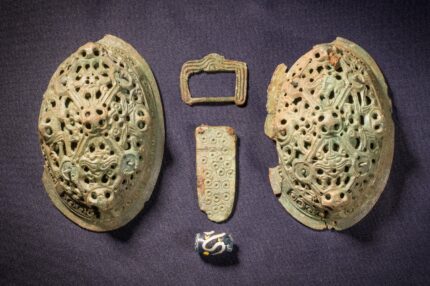Two Viking-era oval brooches that have shed new light on the Viking settlement of the Isle of Man have gone on display for the first time.
The brooches were discovered in December of 2018 by metal detectorists John Crowe and Craig Evans, along with bronze fittings from a belt and a decorated glass bead. The brooches were full of soil when first unearthed. Specialist conservators at the York Archaeological Trust x-rayed, cleaned and waxed them to reveal their intricately interwoven designs in bronze with silver wire decoration. They date to around 900 A.D.
Large, highly-ornamented domed oval brooches like these were worn in pairs by Viking women to fasten the long back straps of their dresses to the two short front straps. The pins were fastened in the front at the shoulders and were sometimes connected with decorated strands of beads. Most of the ones that have been found (primarily in a funerary context) are made of bronze, although a handful of ones made of silver and gold have been found in extremely rich graves.
They were created using a technique derived from late Roman chip-carving in which the complex design was carved into a master model in a soft material — wax, lead, wood — and then cast in bronze. The technique was first used for Roman military belt buckles. It was picked up in the border regions to make fibulae which evolved into the large fastener brooches sported by Viking women.
While men also used brooches to fasten their garments, usually cloaks, the ones found in men’s graves are stylistically very different from the women’s and are individual pieces, not pairs. Pairs of oval concave brooches were exclusively the province of Viking women and have been found in Scandinavia (Sweden, Norway, Denmark) as well as further afield in Britain, Ireland, Russia and Iceland. This is the first pair found on the Isle of Man.
Allison Fox, Curator for Archaeology at MNH said:
“The Isle of Man has a rich Viking heritage and the Manx National Collections reflect this. This type of brooch, worn by Scandinavian women in the Viking Age and usually found in graves, has been missing so far. In addition to the brooches, there was also one decorated glass bead made in Ireland and a belt with bronze fittings, most likely made in the Irish Sea area. Although proud of her Scandinavian roots, this particular pagan lady also wore local fashions”.
Because the brooches have so often been discovered in graves, archaeologists did a follow-up targeted excavation of the find site, hoping to find evidence of this fashionable pagan lady’s burial. They came up empty-handed, alas, and no grave was found where the pair of brooches were found.
The brooches, belt fittings and bead are now on display at the Manx Museum in Douglas.
